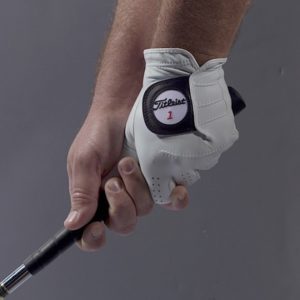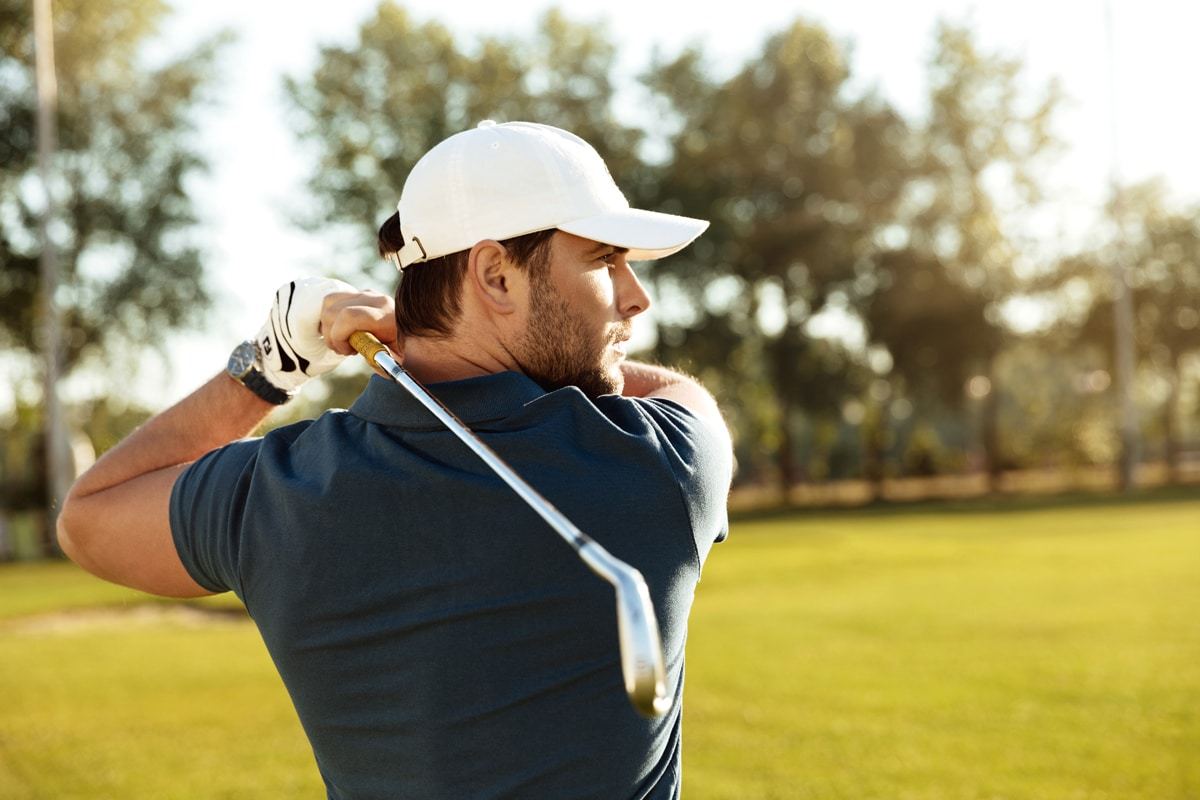One of the most enticing aspects about golf is that it’s an activity that can be picked up by anyone at anytime. Whether you’re a child, a teenager, or a seasoned working professional, there’s no better time to learn golf like the present. Unlike other sports however, golf can be quite a difficult activity to pick-up – and an even harder sport to master.
One of the most difficult techniques to master in golf is also one of the most fundamental – the golf swing. At a cursory glance it may seem simple, but the smallest changes in your stance, grip, and more can drastically affect the trajectory of your ball.
If you’re just starting to pick-up golf or are a seasoned professional looking for tips to improve don’t worry!
This beginners guide will teach you the proper golf swing mechanics and technique step by step.
Take a close look at the following:
How To Hold & Grip A Golf Club For Beginners
Before you pick up a club, you need to understand the basics of a golf swing. In order to properly swing a golf club, there are areas that you’ll need to work to develop first. One of the most important pieces in controlling your swing is learning how to properly grip your club.
The right golf grip will not only improve your ball striking, but make you more consistent, but ultimately improve your game overall.
A proper golf grip may feel uncomfortable at first, but it is important to put a great deal of emphasis on grip. For a beginner, you may think your grip isn’t too important, but it is a large part of your swing.
Once you get a feel for your grip, you want it to become second nature. In fact, many seasoned veterans still put great focus on their grip.
Good golf always begins with a good grip.
A few steps to master proper grip are listed below.
Assess Your Current Grip
First, think about your current hand and grip position when you hold your clubs. Understand that it’s not perfect yet. Imagine you’re about to tee off, now, ask yourself how do you properly hold a golf club? What positions are your fingers in? Are you comfortable with it? How confident are you that you can hit a great shot? Are there things to improve on.
Grip Size
All clubs are designed with a rubberized grip, some varying sizes and thickness. Whatever comes standard on your clubs however may not be the best option for you. If you are struggling to find a good grip on a certain club, it may be due to the grip itself not being right for your hand.
A reputable shop can advise you about the size that best suits your needs. For smaller hands, small grips are ideal. For bigger hands, a larger grip should be taken into account.
Golf Grip Hand Positioning

It’s time to pick up the club and develop your grip. Make sure your left hand is at the top of the club allowing about half an inch of the club to poke out of the top of your grip.
Next, point your left thumb down and put the right hand on top, interlocking your left index and right pinky fingers.
Once you establish your grip, make sure it feels comfortable (it will seem awkward at first). The key here is to no grip too tight where you feel like you have less mobility, but firm enough where you are able to secure the club without it moving during your swing.
If you are not confident in your hand positioning, you can take advantage of special molded grips on the market. They are tailored to instruct you where you need to position your hands, fingers or thumbs. When it comes to price, they are available at a competitive rate. So, relax!
Note: This is the correct golf golf grip for right handed players.
Difference Between Overlapping and Interlocking Golf Grip
Is it necessary to interlock your fingers when holding a golf club? No, it is not required, but is the standard method for holding a golf club.
As a matter of fact, some professionals don’t.
However, interlocking hands together has been known to enhance your swing and creates a more solid grip.
The most popular technique of finger linking is commonly called the Overlapping Grip or the Vardon Grip. Well, it seems difficult to understand, but it’s not as complicated as you think. Usually, the hands are joined together. Golfers place their top hand’s index in between the pinky and ring finger of the bottom hand, just like mentioned above.
Right Pressure
When holding your golf clubs, it is essential to ensure you have the right amount of force applied to your grip.
Your grip should be neither too firm nor too light to control your club.
Gripping the club tightly delivers its heel onto the ball. This causes a loss of control and inconsistent strikes. Obviously, you would know if you’re holding the club too tightly. If you are, you will feel your forearms tense as you go to swing.
Swinging with too much force will negatively impact your swing and shot, so relax your arms and grip the club softly.
Pro Tip: To help you relax your grip, you can wiggle the club to shake off the tension in your wrists and arms before your shot.
Keep Everything Neutral
Neutral grip is the most common way to hold a club. If you are a beginner, this is good to go. As you become more proficient, you and learn other ways.
The rotation of your hands depends in the strength of your grip. When you see two or more knuckles on your left hand, it’s a strong grip. It will close the clubface and impact the ball’s launch angle.
For a soft grip, rotate your hand counter-clockwise. Normally, there are no visible knuckles, and it opens the club face. As a beginner, be willing to experiment with different effects of grip strength.
Alternative Golf Grips
There are no rules about how to grip a golf club. In fact, everyone is different. Some golfers don’t find a regular grip comfortable.
Of course, you can do whatever feels natural and easy. As long as you feel comfortable with your swing and you are striking the ball effectively, then can continue using whatever grip works best for you.
Did you know that professional golfer Jordan Spieth has a very unorthodox way of gripping his clubs? This proves that there’s no right or wrong way to hold a club as long as you are doing so effectively, which he most certainly is.
The Keys To A Perfect Golf Swing
There’s no denying that all golfers want to perfect their golf swing. But despite how much you may practice, you will find that your swing will never be 100% every single time. The casual player does not get out and practice their swing to be as consistent as any professional golfer.
When working on improving your swing, the focus should be on rhythm, speed, and making consistent contact. This is what helps create the most proper golf swing. It will not come easy at first, and you will get frustrated, but it will get much easier to have a consistent rhythm in your swing.
Once you have this down, you will find you’re hitting the ball much more crisp, and this will result in greater ball velocity off the clubs, increased distance, and accuracy.
This will all come in time with repetition and analyzing your swing to understand what you may be doing wrong, and how to improve.
If you feel that you are not making progress in improving your swing, ask someone who understands the mechanics of a golf swing to watch and take note of what you are doing.
More often than not you will find that you are making mistakes without realizing it.
Proper Way to Swing a Golf Club
Ideal Posture
 Your posture plays a vital role in your golf swing. It is important that you are balanced throughout the duration of your golf swing.
Your posture plays a vital role in your golf swing. It is important that you are balanced throughout the duration of your golf swing.
Make sure to bend your knees and at the hips. For many people, it is a natural athletic position where you should feel comfortable.
When properly balanced and bent over, your weight will be centered over the balls of your feet.
This will allow you to turn from side to side to keep your balance easily.
Coil Properly
Throughout your swing, it is important to make sure you “coil” properly. Coiling in this case means twisting. This twisting motion is where the momentum and power in your swing come from.
Every time you start your backswing, you need to keep your arms straight by turning your shoulders. Not only will this help relax your arms, but it will also keep them straight.
If by chance you bend your arms or “break” you will more than likely hit a bad shot. This causes the face of the club to move resulting in a poorly hit ball.
Keep Your Wrists Straight
As you coil, your right elbow will bend naturally if you are a right handed swinger, and this can cause your wrists to bend. Naturally in a golf swing, your back elbow will form an almost 90 degree “L” shape.
If your elbow bends more or less, this can break your wrists, resulting in a poor shot. The breaking of your wrists will change the angle of the club’s face resulting in either pulling or slicing the ball.
Unwind to the Finish Your Swing
Once you have reached the top of your backswing, you can unwind your body to hit the ball and follow through.
While beginning to bring the club down to the ball, it is important to remember to keep your arms and wrists in sync. You want to avoid excessive movement which will hinder the end of your swing, resulting in a poorly hit ball.
When striking the ball, you need to make sure your midsection and arms are moving as a cohesive unit. If your arms come through before your body, or vice versa, you will change the angle of the club head resulting in a poor shot.
As a beginner, the key is to remember to not swing too hard. This is often a challenge as new golfers look to swing hard thinking the ball will go further, when in reality, it will not.
Having a nice, fluid swing will help you strike the ball better and have more consistent and straighter shots.
Effective Golf Swing Tips For Beginners
Being able to have a consistent swing every shot requires immense practice and patience. Most beginners get easily frustrated when learning to golf because they have trouble with their swing.
Here are some quick tips to have a more effective swing.
Keep your Hands Low
For many golfers, their biggest concern is how to minimize the height of every shot. Lower hands mean lower ball fight.
In most cases, using a bigger club and trying to swing smoother will help you achieve a better shot. When people grab a club they assume will work, they tend to swing harder, and in the process, their hands come up.
Keeping your hands lower helps prevent hitting the top of the ball, also known as “topping”. Topping the ball will result in a poor shot that will not travel far.
Keep Your Head Down
 When learning to swing properly, you need to remember to keep your head down. Usually, if you swing too hard, you will raise your head because of momentum. When your head goes up, the rest of your body follows suit. This results in topping the ball like mentioned before.
When learning to swing properly, you need to remember to keep your head down. Usually, if you swing too hard, you will raise your head because of momentum. When your head goes up, the rest of your body follows suit. This results in topping the ball like mentioned before.
Many new golfers are more concerned with seeing where the ball goes off the club rather than watching the club hit the ball first.
Beginners assume they need to follow the ball right away, but there will be plenty of time to see where the ball is once it is hit.
Your Power Comes From Your Body
As a beginner to the game, you need to understand that your whole body is part of your swing. When swinging a golf club, your power comes from your body, similar to a baseball swing or like shooting in Hockey or Lacrosse.
If you swing using only your arms, you will have an inconsistent and weak shot. Hitting a golf ball requires your entire body to move in unison, thus creating a repeatable shot.
Proper Golf Swing Mechanics
Your golf swing should be smooth and continuous, and this is one of the biggest challenges for a beginner. There’s a need to combine unique movements into a composed process which is easier said than done.
Understanding proper golf swing mechanics will help your game become more accurate with your shots.
Whether you want to play golf as a hobby or competitively, it’s imperative to understand proper golf swing mechanics. These can be broken into five sections such as the takeaway, the backswing, the transition, the downswing and impact, and the follow through.
Address The Ball
Before you start your swing, you need to get ready to hit the ball. This is called addressing the ball. This is a critical step in having a good swing. When addressing the ball it is important to align your body in position with the ball.
Typically, you want the ball to be in the middle of your body, but this will depend on what club you are swinging. With the ball in the centerline of your stance, you want to ensure you have good balance and are not too far away with your club.
The Takeaway
The way you start your swing plays a big role in the success of all finishes. An erroneous takeaway will set you off on the unideal foot for a good swing. The worst part is that you won’t recover.
The takeaway should be as smooth as possible. While the lower body is stable and your hands remain quiet, turn your shoulders away from the ball.
Most amateur golfers tent to do more during their takeaway. However, additional motion can just cause trouble, and cause you to lose your balance.
The Backswing
 Technically, the takeaway is part of the backswing. This section refers to the portion of the swing between the takeaway and the transition. This is when you turn your shoulders completely, bringing the club all the way back.
Technically, the takeaway is part of the backswing. This section refers to the portion of the swing between the takeaway and the transition. This is when you turn your shoulders completely, bringing the club all the way back.
When you start your backswing, it’s important to maintain your balance and not come back too quickly. If you have a smooth backswing, you will set yourself up for a good shot.
Once you finish your backswing, remain balanced. Keep your weight evenly distributed and your feet planted.
The Transition
Once you’ve reached the top of your backswing, you need to focus on transitioning your weight to get your body rotating back towards the ball.
The thing to remember here is that you don’t want to shift your weight too quickly or start your hands too soon. If you shift your body before your hands move or your hands come down first, the angle of the club head will change and impact the direction of the shot.
The Downswing and Impact
As your downswing begins, your hands and body should be moving in sync towards the ball. One common issue beginners have with their downswing is that it can be either too violent or sloppy.
Many new golfers have a smooth backswing, but when it comes to the downswing, they swing too hard, or their arms have too much movement.
The key to a good downswing is to be under control of all your body’s movements. This will be hard to get down at first, but once you understand the progression, you will become a more consistent golfer.
The Follow Through
Although you have already hit the ball at this point, you still need to finish your swing and follow through.
While it may not seem as important as hitting the ball, the follow through is very important. Typically, if you end your follow through off balance, that means other parts of your swing were off balanced as well.
Once your swing is finished, you would have twisted your body about 90 degrees, and your weight will be on your front foot.
Conclusion
As a new golfer it can get frustrating to perfect your swing. But, if you are able to practice, understand what you’re doing during your swing, and follow the fundamentals, you will get better. It may not happen in a week or a month, but the more you swing and get comfortable, the better you’ll be.





